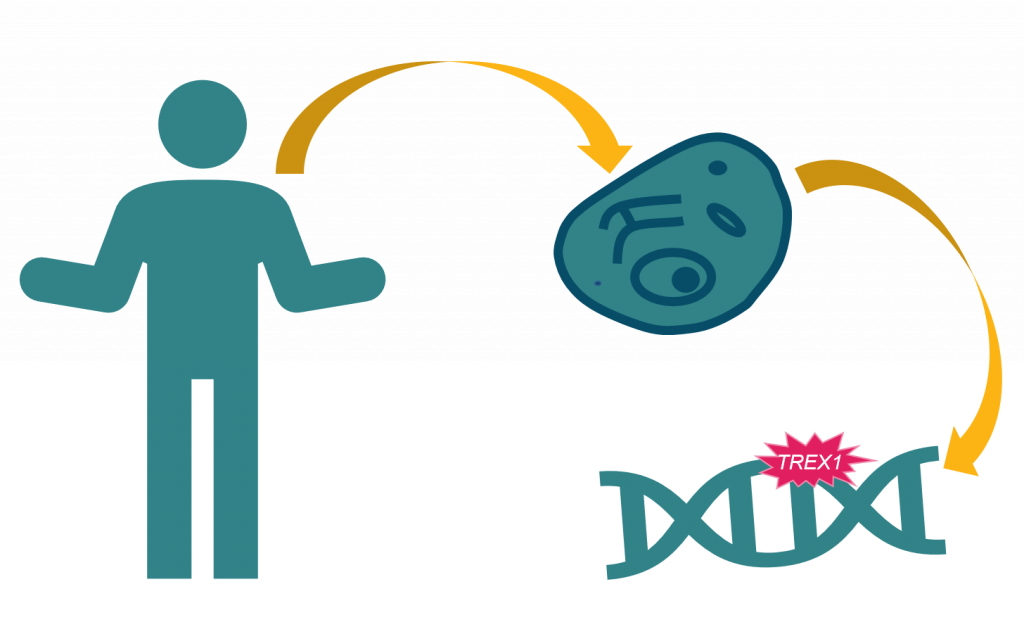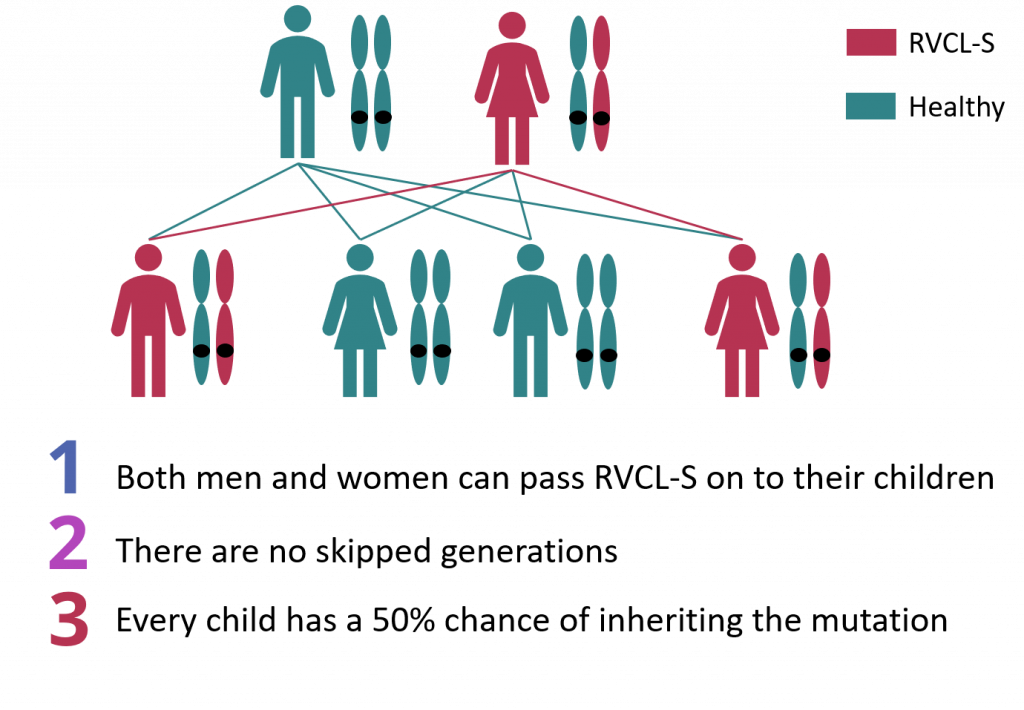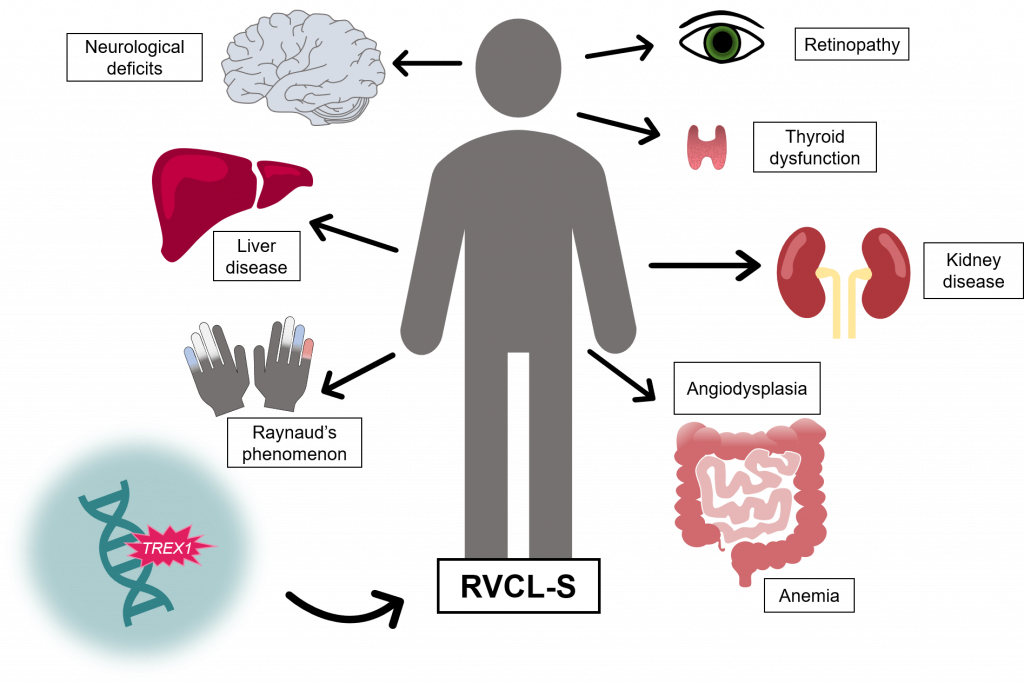Patients
Retinal Vasculopathy with Cerebral Leukoencephalopathy and Systemic manifestations (RVCL-S) is a rare, hereditary disorder. Here both patients and their loved-ones can find information about RVCL-S, the genetics, symptoms and prognosis.
What is RVCL-S?
RVCL-S is an abbreviation of Retinal Vasculopathy with Cerebral Leukoencephalopathy and Systemic manifestations. It is a very rare, hereditary disease. Worldwide little over 25 families with RVCL-S are known.
Previously, RVCL-S was being named Retinal Vasculopathy with Cerebral Leukodystrophy (RVCL). Before that the disease was called Hereditary Vascular Retinopathy (HVR), Cerebroretinal Vasculopathy (CRV), Hereditary Endotheliopathy with Retinopathy, Nefropathy and Stroke (HERNS), and and Hereditary Systemic Angiopathy (HSA).
Retina is a part of the eye. The first complaints are often due to retinopathy.
Vasculopathy means disease of the blood vessels. It is thought that the small blood vessels are damaged throughout the body in RVCL-S.
Cerebral means the disease is located in the brain (cerebrum = brain).
Leukoencephalopathy indicates that the white matter of the brain is affected.
Systemic manifestations signify the damage that can occur in all other organs, such as the kidney, liver and thyroid.
What causes RVCL-S?
RVCL-S is caused by a mutation in the TREX1 gene (for further reading, see Is RVCL-S hereditary? below). Only certain mutations in a small part of the TREX1 gene can cause RVCL-S.
As far as we know, all persons with a RVCL-S mutation will develop symptoms of the disease. However, the age at which the first symptoms occur varies greatly between patients.
It still remains unclear how mutations in TREX1 ultimately lead to disease symptoms. The mutated TREX1 proteins may affect the function of the endothelium (= blood vessel lining) of small vessels throughout the entire body.

Is RVCL-S hereditary?

Yes, RVCL-S is hereditary. It is a so-called autosomal dominant hereditary disease. This means that every child has a 50% chance of inheriting the disease from a parent with RVCL-S. It doesn’t matter whether the mother or the father has RVCL-S. The chance pass down the disease to subsequent children is also 50%.
How does this work?
Every human has 46 chromosomes that are made up of DNA (genetic material). Genes are small pieces of DNA that carry a certain hereditary characteristic. Every person has two copies of each gene, one from his mother and one from his father. So parents always pass one copy of a gene to their children (see picture) and every child has a copy of each gene from the father and one from the mother. In RVCL-S, one of the TREX1 genes is mutated and causes disease.
More information about RVCL-S
What are the symptoms of RVCL-S?
The first complaints are often visual complaints. The vessels in the eyes of RVCL-S patients become damaged (retinopathy = disease of the retina). Eventually, this can lead to visual impairment and even blindness. Here you can read more about retinopathy in RVCL-S.
RVCL-S also leads to symptoms that start in the brain. Small damages to the brain can lead to many different complaints, for instance forgetfulness, cognitive impairment or changes in behavior. Other complaints are depression and anxiety. Sometimes, loved ones or others around patients notice this before the patients themselves. This can lead to conflicts. The damage to the brain can also lead to acute complaints, such as loss of strength in a limb or problems with speech or swallowing. These complaints can disappear completely, partially or unfortunately stay. Another symptom of RVCL-S can be migraine. Here you can read more about the brain in RVCL-S.
Complications of the liver, thyroid or kidney can also occur. While treatment is often not necessary, patients need to be monitored in case this proves necessary. Anemia frequently occurs and can require treatment with iron or blood transfusions. Hypertension can also be caused by RVCL-S and if the blood pressure becomes high enough treatment will have to be started. Raynaud’s phenomenon can occur at the fingers, toes, ears and nose. Fingers for instance can turn pale or white, then blue, and finally red and can become numb.
How is RVCL-S diagnosed?
The diagnosis can be made through DNA testing (a genetic test). Usually, this is done with a blood test to look for mutations in the TREX1 gene. A clinical geneticist can support you with important decisions associated with genetic testing. For example, whether or not you whish to know your mutation status or what to do if you want children.
Is there a treatment for RVCL-S?
As of now, there is no treatment to cure RVCL-S. The goal of treatment is to prevent or slow down organ damage as much as possible and to support patients and their families. We try to postpone the moment that RVCL-S patients are no longer able to perform their daily activities. More information about the treatment of RVCL-S can be found here.
What is the prognosis of RVCL-S?
It is difficult to give an accurate prognosis to individuals with RVCL-S. The age of disease onset, the nature and severity of the disease differ greatly from person to person, even within one family.
The first complaints of RVCL-S usually arise when people are between 30 and 40 years old. Because much is still unknown about RVCL-S, we cannot predict at which age patients will die. This varies greatly from person to person. However, people with RVCL-S have a lower than average life expectancy.

RVCL-S research
At the LUMC a lot of research is performed into RVCL-S (Retinal Vasculopathy with Cerebral Leukoencephalopathy and Systemic manifestations). Our goal is to develop a treatment for this disorder.
We perform fundamental research (= aimed at understanding the disease mechanism) and clinical research. We collaborate with different specialists in the LUMC and with other hospitals and research centers both nationally and internationally. More information about the RVCL-S research can be found here.
Patients Association
RVCL-S has a Dutch Patients Association. Here you can find more information about it.
